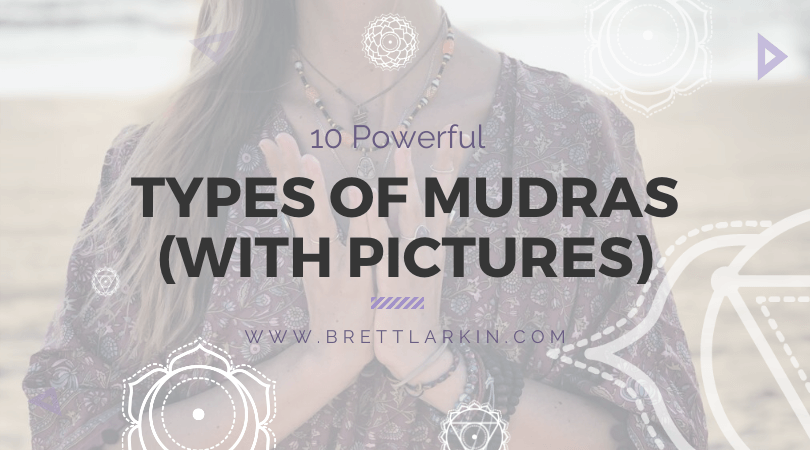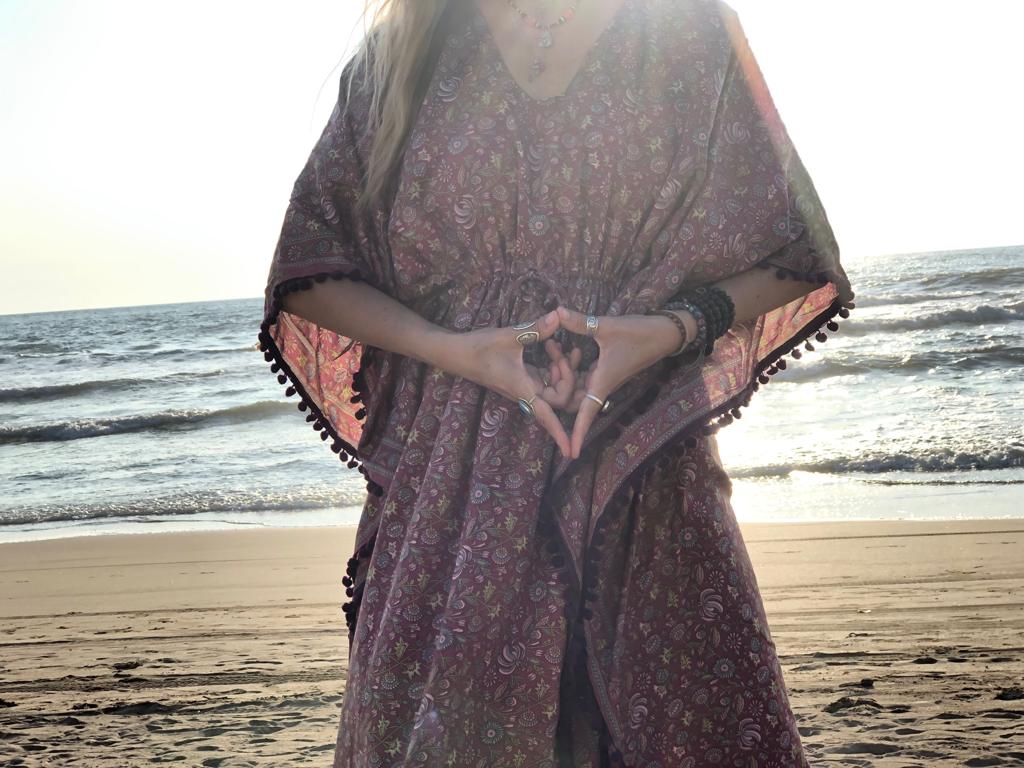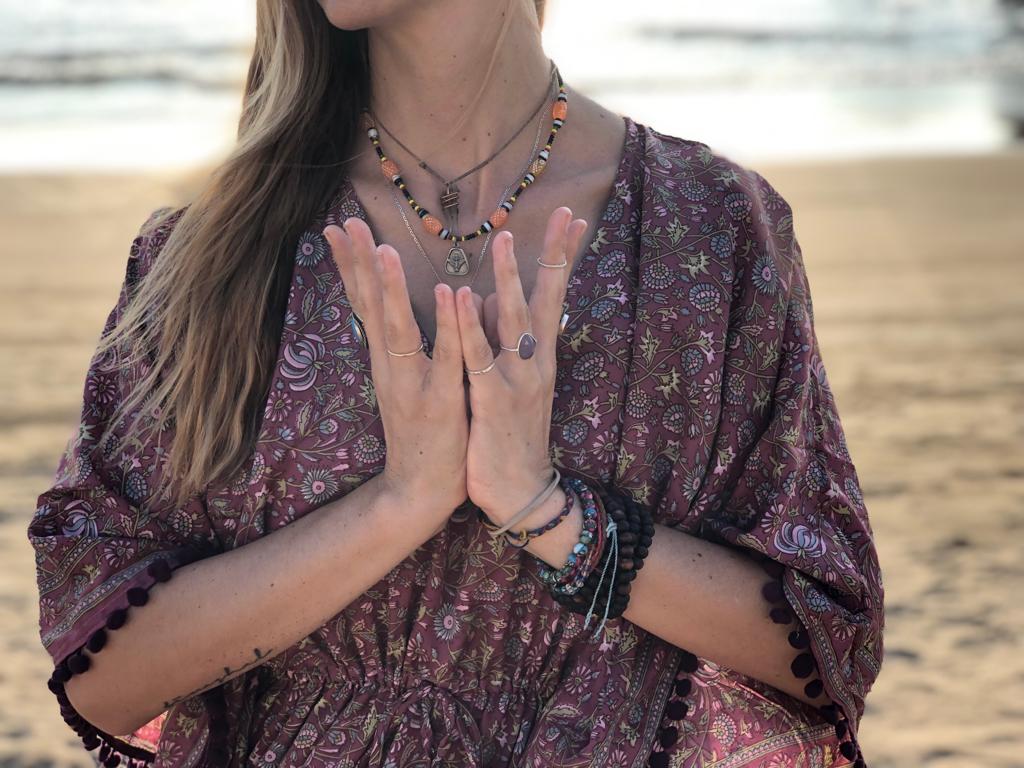
If you’ve been to a yoga or meditation class, odds are your teacher has asked you to make a shape with your hands at some point.
At first, this might seem a little weird, maybe even like it’s one of those yogi terms that’s a bunch of hippie BS. After all, what difference does it really make? And isn’t yoga about postures, not hand symbols?
It’s totally normal to wonder about this part of your yogic practice and that’s what I’m going to break down here 🙂
What Are Yoga Mudras?
Yoga mudras are shapes that you make with your hands, called “hasta mudras”. Hasta is the Sanskrit word for “hand” and mudra means “gesture” or “seal”, and they are found in Hindu, Buddhist, and yogic traditions.
According to the yogic philosophy of the 15th-century text the Hatha Yoga Pradipika, performing these mudras in yoga helps channel pranic energy through the central energetic channel, which aids in the awakening of kundalini energy that then pierces all chakras and knots so that the mind becomes free of connections.
How?
Well, yoga mudras are hand seals and the word seal, in this case, refers to an energetic lock or a specific way that we can seal our life force energy, or prana, within us. These aren’t as strong as the bandhas or “locks” that are used primarily in Pranayama practice (or breathing exercises), but they are a more gentle way to direct the flow of subtle energy.
You can think of it like using an antenna on an old-school radio or TV where the position and shape of the antenna help to direct the energy flow in the device.
We are basically doing this with our bodies in yoga! We make shapes with our bodies and hands to guide the flow of energy to different parts of our bodies, organs, and brains.
You might also like: What Are The Chakras And Kundalini Energy Flow? Here Is My Complete Breakdown.
Think about it.
Most of us have experienced that our mental and emotional states affect how we hold our bodies…
…and have you noticed that there is a difference between how you hold your head, chest, and shoulders when you’re feeling confident versus shy?
Isn’t there a difference between how you walk when you’re happy versus when you’re sad? Your answer is most likely…yes!
So we know that our minds affect our bodies. Well, mudras make use of the fact that the mind-body connection also works the other way around, so by changing our bodies, we can change our minds.
Our minds direct our attention and where our attention goes energy flows. Therefore the beneficial effects of mudras are compounded by the fact that we are getting clear on what we want to shift, cultivate, or focus on in our minds and our minds are powerful (kinda like the placebo-effect).
There are body mudras too but we’ll focus on hand mudras because they are such an accessible yet powerful tool to add to your toolbox.
With just a little shift of your phalanx bones (fancy words for finger bones) you might just shift your whole outlook or mood to become more focused, energetic, compassionate, or whatever you need! According to yogic philosophy, hasta mudras can even do things like affect your blood circulation and mitigate diseases.
Pretty cool, huh?
You might also like: Understanding The 8 Limbs of Yoga: The Surprising Truth About Yoga
10 Meditation Hand Positions with Pictures
Begin by finding a meditative posture. Sit with your weight evenly between your sitting bones and the bowl of the pelvis tilted slightly forward so that your spine can lengthen upwards more effortlessly. Allow your eyes to softly close and become aware of your breath.
Use the instructions below to guide you into a mudra. Your hands likely aren’t used to the shapes, so be patient and don’t force it uncomfortably! Use minimal pressure so you don’t have any tension in the hands. You can try performing with one hand at a time and switch hands when one fatigues as you’re getting used to these.
Aim to hold the mudra for 15 minutes 1-3 times per day, or once a day for 45 minutes. But it’s not an exact science and of course, any amount of time is more helpful than none. Once again, I encourage you to try these out and see for yourself what amount of time is needed for you to feel an inner shift!
Here are ten mudras to explore during your sitting meditation or pranayama practice. Happy hasta mudra-ing!
1. Apana Mudra

Instructions: Connect the tip of your thumb to the tips of the middle and ring fingers while keeping the other fingers extended. Allow the backs of the hands to rest on your knees or thighs.
Benefits: Apana vayu (vayu is Sanskrit for “wind”) is a downward moving current of energy, which helps with elimination and therefore with detoxification of the body. It can also help with digestion, both mental and physical, that are believed to occur at the solar plexus, the area above the navel. You might try this mudra if you’re constipated or when you feel like you’re holding onto something physically, mentally, or emotionally that you’re ready to let go of.
2. Vitarka Mudra

Instructions: With your right hand, connect the tip of the thumb to the tip of your index finger. Bend your elbow and raise your hand to shoulder height with your middle, ring, and pinky fingers pointing upwards.
Benefits: Vitarka Mudra promotes the energy of teaching and is said to facilitate discussion. Use this before a tricky conversation or meeting to help enter a more agreeable or friendly state.
3. Dharmachakra Mudra

Instructions: Connect the tip of the thumb and the tip of the index finger on both hands. Bring hands to heart level and face the right palm outward and the left palm upwards. Then touch the joined tips of the right index finger and thumb to the tip of the left middle finger while the left ring and pinky fingers stay gently extended.
Benefits: Dharmachakra means “wheel of cosmic order” and represents the circle of life, death, and rebirth. It helps us elevate our state of mind beyond our present limited experience of ourselves, thereby it can also help calm and focus the mind and improve our attitude, even inspiring us to contribute to society. Give it a try when you’re feeling in a funk and caught up in your own “stuff” and you want to shift to a broader perspective or one of selflessness and giving back.
4. Yoni Mudra

Instructions: Join the tips of the thumbs and then the tips of the index fingers and let the remaining fingers fold down. Allow this shape to rest on the lower abdomen with the thumbs at the navel and the pointer fingers pointing downwards.
Benefits: Yoni means womb and this mudra helps give us that “womb-like” feeling of turning off the outside world, drawing our attention inwards, and being protected. Thus it can help to calm the mind and improve mental clarity and relaxation. Give this one a go when you’re transitioning from a busy day at work or with family and want to reconnect with yourself and enter a more focused and relaxed internal state.
5. Karana Mudra

Instructions: With the right hand, connect the tip of your thumb to the tip of your middle finger. Allow the ring finger to bend and rest next to the middle finger and keep the pinky and index fingers stretched. Bend your elbow and raise your hand to shoulder height with the index and pinky fingers pointing upwards.
Benefits: Karana mudra, or “the gesture for warding off evil”, is believed to remove obstacles and expel negative energy. In our modern lives, this “evil” is most often things like anxiety, stress, and depression. Practice this mudra when you feel stuck in a cloud of overwhelm or negativity and you want to elevate your mindset.
6. Dhyana Mudra

Instructions: With both palms facing up, rest the left hand in the lap and place the right hand on top of the left with the fingers of the right hand stacked on those of the left. Keep the four fingers straight and gently touch the tips of the thumbs together.
Benefits: Dhyana mudra, also known as “the gesture of meditation”, helps with concentration, balancing the thoughts and the senses, and promoting tranquility. Since it’s most helpful with contemplation and spiritual pursuits, try this mudra when you want to deepen your meditation.
7. Lotus Mudra

Instructions: Bring your hands together in prayer position in front of your heart. Keep the edges of the thumbs, pinky fingers, and heels of the hands connecting as you draw the other fingers and the palms away from each other to form the shape of a blooming flower.
Benefits: The lotus is a flower that grows in muddy water, rises to the surface, and blooms untouched by the impurity of the mud. Hence, this mudra inspires perseverance and opens our hearts to ourselves and others throughout our constant overcoming of obstacles without becoming jaded by our hardships. It’s believed to help open our hearts and balance the heart chakra to overcome desire, fear, and attachment. Perform this mudra when you want to remember your ability to overcome challenges, how beautiful it is to do so, and when you want to cultivate compassion for yourself and others.
8. Gyan Mudra

Instructions: With one or both hands, connect the tip of your thumb to the tip of your index finger and straighten your remaining fingers. Allow your hands to rest on your knees palms facing up.
Benefits: Gyan mudra is called “the gesture of knowledge” as it’s believed to improve concentration and memory, help gain insight and knowledge, and connect individual consciousness with universal consciousness. It can also improve our physical balance and balance the root chakra to relieve tension and depression. Try this mudra when you want to cultivate focus or when you’re feeling stressed or isolated and want to reconnect.
9. Vayu Mudra

Instructions: Bend your index finger and use the thumb to gently maintain it in the folded position so the tip of the index finger connects with the base of the thumb. Keep the remaining fingers extended and allow the back of the hands to rest on your knees or thighs.
Benefits: Vayu mudra is believed to balance the air element in the body, therefore it is supposed to help with neurological disorders that are related to excess air elements such as gout, arthritis, and Parkinson’s disease. If you don’t have issues with these things, you can also practice this mudra when your mind is feeling scattered, anxious, or unsettled.
10. Varuna Mudra

Instructions: Join the tip of the pinky finger with the tip of the thumb using light pressure and keep the remaining fingers comfortably extended. Rest the backs of your hands on your thighs or knees.
Benefits: Varuna mudra is known as the “gesture of mental clarity” and it balances the water element. Mentally, this gesture is thought to encourage open and fluid communication and to help balance and process emotions. Physically it can help with dryness, liver or kidney issues, and fluid and blood circulation. You might try this mudra when you feel dehydrated or overwhelmed by emotions.
How’d it go?! Notice some shifts? If so, in addition to practicing these hasta mudras while meditating, you can try them while doing a yoga pose or even while walking!
If you’re feeling intrigued and want to learn more about these mudras and other ancient yogic techniques, you might consider a Hatha yoga teacher training and see how to further explore how tools like these can help you to live a happier and healthier life!
Experience 3 Training Videos from Inside My 200-Hour Online YTT

YOU MIGHT ALSO LIKE
- What is Kriya Yoga? The Philosophy and Practice
- Uddiyana Bandha: Tapping Into Your Deep Core
- 4 Reasons Hasta Bandha Is Essential To Your Yoga Practice
- Vitarka Mudra: What It Is and How Do You Use It?
- Shakti Mudra: What It Is and How Do You Do It?
- Garuda Mudra: What It Is and How Do You Use It?
- Kali Mudra: What It Is and How Do You Do It?
- Shunya Mudra: What It Is and How Do You Do It?
- Varuna Mudra: What It Is and How Do You Use It?
- Vayu Mudra: What It Is and How Do You Use It?
- Samana Vayu: The Energy of Balance & How to Access It
- Apana Vayu: The Energy of Release & Surrender
- Udana Vayu: The Ascending Wind
- Prana Vayu: The Breath of Vitality
- Vyana Vayu: The Energetic Secret to Flow
Learn how to do 11 of the most popular yoga poses correctly. Free video + PDF download.










